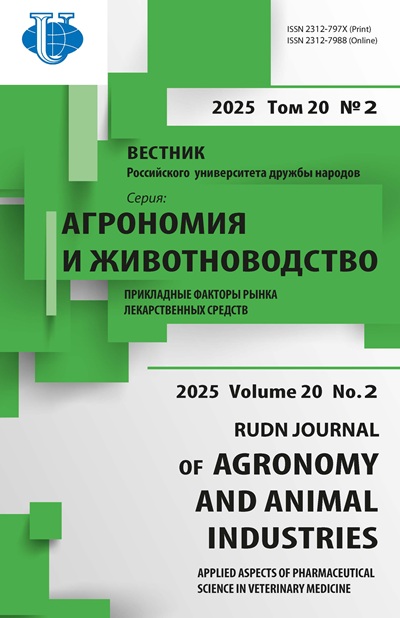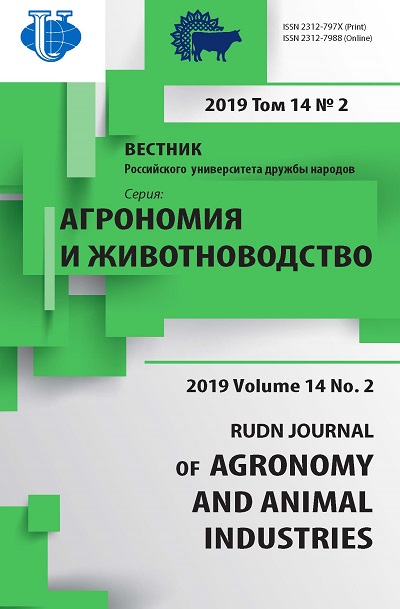ДНК-инсектициды как новое направление в защите растений и обеспечении продовольственной безопасности
- Авторы: Ниадар П.М.1, Разо Ш.1
-
Учреждения:
- Российский университет дружбы народов
- Выпуск: Том 14, № 2 (2019)
- Страницы: 105-113
- Раздел: Растениеводство
- URL: https://agrojournal.rudn.ru/agronomy/article/view/19488
- DOI: https://doi.org/10.22363/2312-797X-2019-14-2-105-113
- ID: 19488
Цитировать
Полный текст
Аннотация
Большое число повреждений растений вызывается насекомыми, которые могут одновременно являться как вредителями, так и переносчиками болезней, что создает серьезные проблемы продовольственной безопасности. Крайне важным для человеческого роста и развития является доступ к безопасным и высококачественным продуктам питания. Это становится залогом развития общества потребителей с высокими требованиями к качеству продуктов питания и, в конечном итоге, приводит к постоянно растущему спросу на подобную продукцию. Влияние экологических, биологических, химических, политических и социально-экономических факторов способствовало формированию современного продовольственного рынка, его доступности и безопасности. Именно поэтому разработка безопасных биологических препаратов становится сегодня приоритетом в современной системе защитных мероприятий. Данная работа систематизирует отдельные результаты по исследованию защитных свойств немодифицированных коротких одноцепочечных фрагментов ДНК, используемых в качестве инсектицидов, как новый инструмент в системе защиты растений.
Ключевые слова
Об авторах
Палма Мута Ниадар
Российский университет дружбы народов
Автор, ответственный за переписку.
Email: biopalmgene@gmail.com
стажер Агробиотехнологического департамента, Аграрно-технологического института
Москва, Российская ФедерацияШиатесса Разо
Российский университет дружбы народов
Email: razo_sh@rudn.university
аспирант Агробиотехнологического департамента, Аграрно-технологического института
Москва, Российская ФедерацияСписок литературы
- Fedoroff N.V. Food in a future of 10 billion // Agriculture & Food Security. 2015. Vol. 4. № 1. P. 11. doi: 10.1186/s40066-015-0031-7.
- Christou P., Twyman R.M. The potential of genetically enhanced plants to address food insecurity // Nutrition research reviews. 2004. Vol. 17. № 1. P. 23—42. doi: 10.1079/NRR200373.
- FAO. The State of Food Insecurity in the World (SOFI). Режим доступа: www.fao.org/ FOCUS/E/SOFI00/SOFI001-e.htm. [Дата обращения 11.01.2018].
- James C.L. Global food security // Abstracts, 7th International Congress of Plant Pathology. Edinburgh, UK, 1998. No 4.1.
- Maxwell S. Food security: a post-modern perspective // Food policy. 1996. Vol. 21. № 2. P. 155—170. doi: 10.1016/0306-9192(95)00074-7.
- DESA. World population prospects: the 2012 revision. Department of Economic and Social Affairs, United Nations, 2013. Working Paper No. ESA/P/WP.228.
- Gerland P., Raftery A.E., Ševčíková H., Li N., Gu D., Spoorenberg T., et al. World population stabilization unlikely this century // Science. 2014. Vol. 346. № 6206. P. 234—237. doi: 10.1126/science.1257469.
- Brzozowski L., Mazourek M. A sustainable agricultural future relies on the transition to organic agroecological pest management // Sustainability. 2018. Vol. 10. № 6. P. 2023. doi: 10.3390/su10062023.
- Juroszek P., von Tiedemann A. Plant pathogens, insect pests and weeds in a changing global climate: A review of approaches, challenges, research gaps, key studies and concepts // Journal of Agricultural Sciences. 2013. Vol. 151. № 2. P. 163—188. doi: 10.1017/S0021859612000500.
- Oberemok V.V., Skorokhod O.A. Single-stranded DNA fragments of insect-specific nuclear polyhedrosis virus act as selective DNA insecticides for gypsy moth control // Pesticide Biochemistry and Physiology. 2014. Vol. 113. P. 1—7. doi: 10.1016/j.pestbp.2014.05.005.
- May R.M. How many species are there on earth? // Science (Washington). 1988. Vol. 241. № 4872. P. 1441—1449. doi: 10.1126/science.241.4872.1441.
- Dhaliwal G.S., Vikas J., Dhawan A.K. Insect pest problems and crop losses: changing trends // Indian Journal of Ecology. 2010. Vol. 37. № 1. P. 1—7.
- Oerke E.C. Crop losses to pests // The Journal of Agricultural Science. 2006. Vol. 144. № 1. P. 31—43. doi: 10.1017/S0021859605005708.
- Pan P., Qin Y. Genotypic diversity of soybean in mixed cropping can affect the populations of insect pests and their natural enemies // International Journal of Pest Management. 2014. Vol. 60. № 4. P. 287—292. doi: 10.1080/09670874.2014.974725.
- Herniou E.A., Arif B.M., Becnel J.J., Blissard G.W., Bonning B., Harrison R.L., et al. Baculoviridae // Virus Taxonomy: Classification and Nomenclature of Viruses: Ninth Report of the International Committee on Taxonomy of Viruses / King A.M.Q., Adams M.J., Carstens E.B., Lefkowitz E.J. (eds.) Oxford: Elsevier, 2011. pp. 163—174.
- Herniou E.A., Olszewski J.A., O'reilly D.R., Cory J.S. Ancient coevolution of baculoviruses and their insect hosts // Journal of Virology. 2004. Vol. 78. № 7. P. 3244—3251. doi: 10.1128/JVI.78.7.3244-3251.2004.
- Rohrmann G.F. Baculovirus Molecular Biology. 3rd ed. Bethesda (MD): National Center for Biotechnology Information (US), 2013.
- Pineda A., Kaplan I., Bezemer T.M. Steering soil microbiomes to suppress aboveground insect pests // Trends in Plant Science. 2017. Vol. 22. № 9. P. 770—778. doi: 10.1016/j.tplants.2017.07.002.
- Haase S., Sciocco-Cap A., Romanowski V. Baculovirus insecticides in Latin America: historical overview, current status and future perspectives // Viruses. 2015. Vol. 7. № 5. P. 2230—2267. doi: 10.3390/v7052230.
- Nyadar P.M, Zaitsev A.S., Adeyemi T.A., Shumskykh M.N., Oberemok V.V. Biological control of gypsy moth (Lymantria dispar): an RNAi-based approach and a case for DNA insecticides // Archives of Biological Sciences. 2016. Vol. 68. № 3. P. 677—683. doi: 10.2298/ABS150828041N.
- Oberemok V., Nyadar P., Zaitsev O., Levchenko N., Shiytum H., Omelchenko O. Pioneer evaluation of the possible side effects of the DNA insecticides on wheat (Triticum aestivum L.) // International Journal of Biochemistry and Biophysics. 2013. Vol. 1. P. 57—63. doi: 10.13189/ijbb.2013.010302.
- Oberemok V.V., Nyadar P.M. Investigation of mode of action of DNA insecticides on the basis of LdMNPV IAP-3 gene // Turkish Journal of Biology. 2015. Vol. 39. P. 258—264. doi: 10.3906/biy-1406-56.
- Nyadar P.M., Oberemok V.V., Zubarev I.V. A small molecule for a big transformation: topical application of a 20-nucleotide-long antisense fragment of the DIAP-2 gene inhibits the development of Drosophila melanogaster female imagos // Archives of Biological Sciences. 2018. Vol. 70. № 1. P. 33—39. doi: 10.2298/ABS170302023N.
- Oberemok V.V., Laikova K.V., Zaitsev A.S., Shumskykh M.N., Kasich I.N., Gal’chinsky N.V., et al. Molecular alliance of Lymantria dispar multiple nucleopolyhedrovirus and a short unmodified antisense oligonucleotide of its anti-apoptotic IAP-3 gene: a novel approach for gypsy moth control // International Journal of Molecular Sciences. 2017. Vol. 18. № 11. P. 2446. doi: 10.3390/ijms18112446.
- Oberemok V.V., Laikova K.V., Zaitsev A.S., Nyadar P.M., Shumskykh M.N., Gninenko Y.I. DNA insecticides based on iap3 gene fragments of cabbage looper and gypsy moth nuclear polyhedrosis viruses show selectivity for non-target insects // Archives of Biological Sciences. 2015. Vol. 67. № 3. P. 785—792. doi: 10.2298/ABS141230037O.
- Nyadar P.M., Adeyemi T.A. DNA insecticides: the lethal potency of LdMNPV IAP-2 gene antisense oligonucleotides in pre-infected gypsy moth (Lymantria dispar L.) larvae // International Journal of Pest Management. 2018. Vol. 64. № 2. P. 173—177. doi: 10.1080/09670874.2017.1359432.
- Оберемок В.В., Лайкова Е.В., Зайцев А.С., Ниадар П.М., Гущин В.А., Макаров В.В. и др. Создание ДНК-инсектицидов-новое направление в защите растений // Защита и карантин растений. 2016. № 11. С. 14—16.
- Susurluk H., Toprak U., Gürkan M.O. Concentration of sodium dodecyl sulfate used in occlusion body extraction affects Spodoptera littoralis nucleopolyhedrovirus biological activity // Turkish Journal of Biology. 2013. Vol. 37. P. 171—175. doi: 10.3906/biy-1204-50.
- Zaitsev A.S., Omel'chenko O.V., Nyadar P.M., Oberemok V.V. Influence of DNA oligonucleotides used as insecticides on biochemical parameters of Quercus robur and Malus domestica // Bulletin of the Transilvania University of Brasov. Series II: Forestry, Wood Industry, Agricultural Food Engineering. 2015. Vol. 8. № 2. P. 37—46.
Дополнительные файлы















